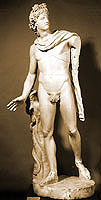Ancient authors and modern archaeologists
The survival of Greek and Latin texts and the rediscovery of the physical remains of classical antiquity, particularly in Rome and its environs, gave birth to the Renaissance. When ancient statues were found from the fifteenth century onwards, the finest were acquired by popes and members of the nobility. Apollo Belvedere, for example, on the left, was recorded in the Vatican by 1509. Those who knew ancient texts were tempted to associate the statues with descriptions of masterpieces by the finest Greek sculptors. Most, like Apollo, however, were either Roman, or Roman copies of Greek originals, and few had specific features that could be paralleled closely in Greek or Roman texts.
The first certain identification came in 1849 when a marble statue of a youth was found in the Trastevere district of Rome (right). The athletic physique and the action of scraping the body clean with a strigil enabled the German archaeologist Emil Braun to recognise a copy of the bronze Apoxyomenos made by the Greek sculptor Lysippos in the fourth century BC. Pliny described the statue in his Natural History, written in the first century AD. He tells how it was brought to Rome and set up outside the Baths of Agrippa, how the emperor Tiberius liked the statue so much that he had it moved to his bedroom, and how the populace campaigned for its reinstatement. When a marble copy was discovered in Rome it was considered so important that it was restored by the contemporary sculptor Pietro Tenerani, and published by architect and antiquarian Luigi Canina.







